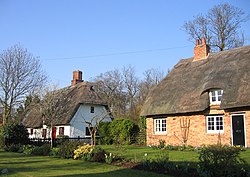Croxton, Cambridgeshire
| Croxton | |
| Cambridgeshire | |
|---|---|
 Cottages on the High Street, Croxton | |
| Location | |
| Grid reference: | TL244600 |
| Location: | 52°13’27"N, 0°10’49"W |
| Data | |
| Population: | 163 |
| Post town: | St Neots |
| Postcode: | PE19 |
| Dialling code: | 01480 |
| Local Government | |
| Council: | South Cambridgeshire |
| Parliamentary constituency: |
South Cambridgeshire |
Croxton is a village in Cambridgeshire found about 13 miles west of the county town, Cambridge. In 2001, the resident population was 163 people. Croxton Park is to the south of the current village and contains a large house and parkland.
In Croxton Park is a large mansion with wooded parkland and a lake, the historic seat of the Leeds family. The current red brick, three-storey house was constructed around 1760-1 by Edward Leeds and probably incorporated part of the previous Tudor building. Sir (George) Douglas Cochrane Newton, Member of Parliament for Cambridge (and later 1st Baron Eltisley) was lord of the manor and principal landowner in 1929.[1]
Name
The name of the village was spelled Crochestone in the 1086 Domesday Book. The name is believed to be for the Old English Croh tun, meaning "Crocus farmstead / village"; crocuses are grown for their saffron. This would be a similar derivation to that of the nearby village of Croydon. Another theory has it that it is "Krókr's village,[2] after an otheriwse unknown Danish owner.
Parish church
The parish church is St James's Church, which stands south of Croxton Park, close to the manor house.[3] A church at Croxton was first mentioned around 1217 and parts of today's church date from the 13th century.
The church is built mainly of fieldstones in the Perpendicular style; the tower has a clock and six bells.[1] The church is a Grade II* listed building.[4][5]
History
Croxton may have been part of a late Scandinavian settlement, along with Caxton and Toft, if the Krókr theory for its name is correct.[3]
It is likely that the settlement grew up on two sites: around the old manor house of Westbury, at the south end of the village, and around the old manor house of Croxton. It seems that a street to the east of the church formed the main village. By 1811 it had already reduced in size, and after enclosure in 1818, the rectory was demolished and an ornamental lake created on its site. By 1826, all the houses had gone and only Croxton Park mansion remained.[3]
At Westbury, the green at the north end of the village street was enclosed and a large house, The Downs, and a farm were built on it. At the south end of the street is a late mediæval timber-framed house called Croxton Manor but it was probably the original Westbury manor house. Westbury Farm was probably an earlier site for the manor house - the farmhouse has several mediæval parts and remains of a moat.[3]
In 1801, 171 people lived in Croxton parish; in 1821, 225 people. The population grew, though it declined between 1841–1851, when the mansion was unoccupied and there was emigration overseas from the area. Croxton's population peaked at 308 in 1871; in 1961 it was 155.[3]
Aboyut the village
The grand house of Croxton is Croxton Park, a large mansion with wooded parkland and a lake to the south of the village.
The parish war memorial, commemorates fallen Croxton men of the two World Wars.[6]
A total of 13 structures in the parish are listed, including a milestone by the A428,[7] a cross in the churchyard,[8] a 19th Century village pump[9] and several cottages.
Outside links
| ("Wikimedia Commons" has material about Croxton, Cambridgeshire) |
References
- ↑ 1.0 1.1 Information on Croxton, Cambridgeshire from GENUKI
- ↑ Mills, A.D. (1998). A Dictionary of English Place-names. Second Edition. Oxford University Press, Oxford. p105. ISBN 0-19-280074-4
- ↑ 3.0 3.1 3.2 3.3 3.4 'Parishes: Croxton', A History of the County of Cambridge and the Isle of Ely - Volume 5 (1973), pp. 36-46
- ↑ Images of England — details from listed building database (51132) St James Church, Croxton
- ↑ St James, Croxton – Cambridgeshire Churches
- ↑ Roll of Honour: Croxton
- ↑ Images of England — details from listed building database (51125) Milestone on Cambridge Road
- ↑ Images of England — details from listed building database (51133) Churchyard cross
- ↑ Images of England — details from listed building database (51141) Village Pump
